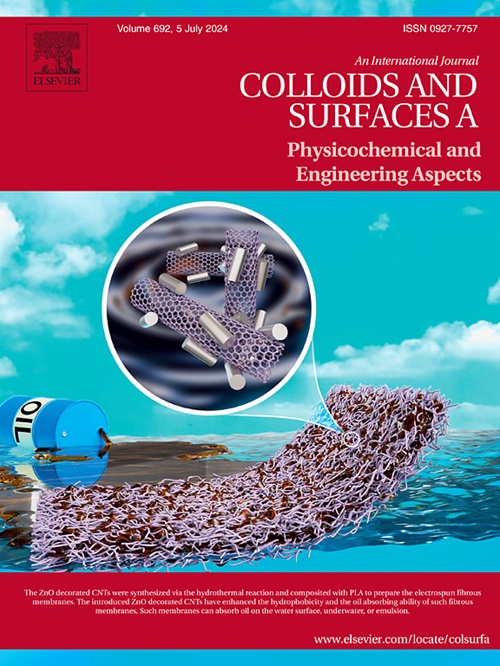Role of cellulose, phenolic compounds, and water-soluble proteins in ZnO nanoparticle synthesis using Mangifera indica leaf extract for photocatalytic and antioxidant investigations
IF 4.9
2区 化学
Q2 CHEMISTRY, PHYSICAL
Colloids and Surfaces A: Physicochemical and Engineering Aspects
Pub Date : 2025-04-28
DOI:10.1016/j.colsurfa.2025.137066
引用次数: 0
Abstract
The green synthesis of zinc oxide nanoparticles (ZnO NPs) using plant-derived macromolecules offers an eco-friendly and sustainable approach to nanomaterial fabrication. In this study, Mangifera indica (MI) leaf extract, rich in cellulose, phenolics (mangiferin, quercetin), and water-soluble proteins, was employed as a natural reducing, capping, and stabilizing agent for the synthesis of ZnO NPs. The resulting NPs exhibited a hexagonal prism morphology, wurtzite crystal structure, and an average crystallite size of 61.5 nm. Zeta potential measurements confirmed excellent colloidal stability with a well-defined isoelectric point at pH 9.51, ensuring robust dispersion behavior. BET surface area analysis revealed a high specific surface area (125 m²/g) and mesoporous architecture, favoring enhanced adsorption and catalytic efficiency. UV-Vis spectroscopy indicated a narrowed bandgap of 2.9 eV, attributed to defect states and biomolecule interactions, facilitating improved light-harvesting ability. The photocatalytic performance of ZnO NPs was evaluated via Rhodamine B dye degradation, achieving 94 % degradation within 120 minutes under UV irradiation, following pseudo-first-order kinetics (k = 0.0275 min⁻¹). The mechanism, assessed through reactive species scavenging, identified hydroxyl (•OH) and superoxide (•O₂⁻) radicals as dominant oxidative agents. Additionally, ZnO NPs exhibited strong antioxidant activity, with 87.5 % DPPH radical scavenging efficiency at 12 mg/L and a total antioxidant capacity (IC₅₀ = 11.7 mg/L). These results highlight the synergistic role of bioactive macromolecules in tailoring the surface chemistry, dispersion stability, and functional performance of ZnO NPs, making them promising candidates for environmental remediation and biomedical applications.
纤维素、酚类化合物和水溶性蛋白在芒果叶提取物合成ZnO纳米颗粒中的作用及其光催化和抗氧化研究
利用植物来源的大分子绿色合成氧化锌纳米粒子(ZnO NPs)为纳米材料的制造提供了一种环保和可持续的方法。本研究以富含纤维素、酚类物质(芒果苷、槲皮素)和水溶性蛋白质的芒果叶提取物作为天然还原、封盖和稳定剂合成ZnO NPs。所制得的NPs具有六棱柱形态,纤锌矿晶体结构,平均晶粒尺寸为61.5 nm。Zeta电位测量证实了优异的胶体稳定性,在pH值为9.51时具有明确的等电点,确保了强大的分散行为。BET表面积分析表明,该材料具有高比表面积(125 m²/g)和介孔结构,有利于提高吸附和催化效率。紫外可见光谱显示,由于缺陷态和生物分子相互作用,其带隙缩小为2.9 eV,有利于提高光捕获能力。通过罗丹明B染料降解来评价ZnO NPs的光催化性能,在UV照射下,在120 分钟内达到94 %的降解,遵循伪一级动力学(k = 0.0275 min⁻¹)。通过活性氧清除来评估其机制,确定了羟基(•OH)和超氧(•O₂⁻)自由基是主要的氧化剂。此外,ZnO NPs表现出很强的抗氧化活性,在12 mg/L时具有87.5 %的DPPH自由基清除效率和总抗氧化能力(IC₅₀= 11.7 mg/L)。这些结果强调了生物活性大分子在调整ZnO NPs的表面化学,分散稳定性和功能性能方面的协同作用,使其成为环境修复和生物医学应用的有希望的候选者。
本文章由计算机程序翻译,如有差异,请以英文原文为准。
求助全文
约1分钟内获得全文
求助全文
来源期刊
CiteScore
8.70
自引率
9.60%
发文量
2421
审稿时长
56 days
期刊介绍:
Colloids and Surfaces A: Physicochemical and Engineering Aspects is an international journal devoted to the science underlying applications of colloids and interfacial phenomena.
The journal aims at publishing high quality research papers featuring new materials or new insights into the role of colloid and interface science in (for example) food, energy, minerals processing, pharmaceuticals or the environment.

 求助内容:
求助内容: 应助结果提醒方式:
应助结果提醒方式:


